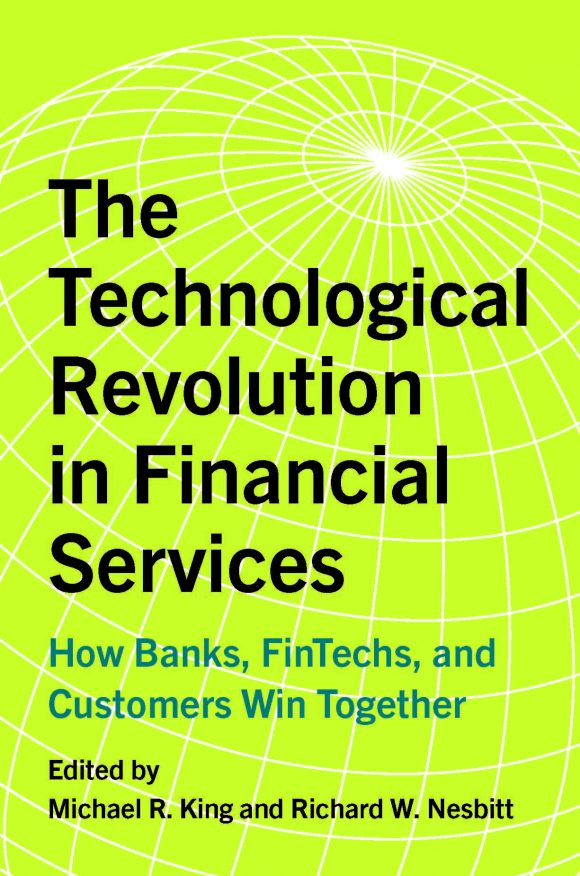By Dr. Michael King. Excerpted from his chapter “The Competitive Threat from Techfins and Bigtech in Financial Services.” King, M. & Nesbitt, R. (Eds.) (2020) The Technological Revolution in Financial Services: How Banks, Fintechs, and Customers Win Together, (pp. 201-227) Toronto, ON: University of Toronto Press.

Imagine this scenario. A young woman opens an app on her mobile phone. She chats and messages her friends over social media, posts photos, plays games, shops for whatever she needs, orders from a restaurant, buys tickets to a concert, arranges transportation, watches videos, listens to music, and books travel. She pays for all of it using her online account, transfers cash between her money market fund and bank account, takes out an unsecured loan, buys and sells investments, sends and receives money, and buys insurance. All of this within one app.
While this story may once have seemed fictional, it is now a reality and currently available on the WeChat app from the Chinese technology company Tencent or on the Alipay app from its rival Ali-baba. Both companies have built online marketplaces and mobile apps that combine e-commerce, social networking, and gaming. They also offer financial products, including payments, deposits, loans, investments, bank accounts, and insurance. Their platform ecosystems now connect more than a billion users with a wide variety of non-financial and financial services manufactured in-house or by third parties. Similar services may one day be available from U.S. companies like Amazon, Apple, Google, or Facebook.
These Chinese technology companies are known as “techfins,” a term first coined by Alibaba’s Jack Ma in 2016 to describe Ant Financial – the financial services arm of the Alibaba ecosystem. Ma argues that techfins are harnessing technology to redefine financial services and increase financial inclusion. He contrasts this mission with the goal of fintech companies that use technology to profit from selling financial products to customers. Ant Financial’s stated purpose is to provide access to capital and financial services to young people, small businesses, and poor nations that are underserved or unbanked:2
“Fintech takes the original financial system and improves its technology,” said Ma …“TechFin is to rebuild the [financial] system with technology. What we want to do is to solve the problem of a lack of inclusiveness.”
Ultimately, techfins purport to use technology to create a world where customers have access to financial services just like tap water – you open the tap and water just flows out.3
From being a minority view several years ago, the new consensus among bank insiders and industry commentators is that techfins like Alibaba and Tencent, not fintechs, represent a greater threat over the next decade to banks, asset managers, insurance companies, and other financial incumbents.
The other threat comes from a diverse collection of North American technology companies known collectively as bigtech (or big tech).4 Bigtech companies are Amazon, Apple, Facebook, and Google, where the term highlights that their main competitive strength comes from massive datasets on customer transactions and behavior in their platform ecosystems (Frost et al., 2019). As noted by the Bank for International Settlements (BIS), bigtech is an apt name, as the stock market capitalization of these large technology companies was bigger than that of some of the world’s largest financial institutions, including JPMorgan, Bank of America, and Wells Fargo in the United States and the Industrial and Commercial Bank of China and the China Construction Bank.5
Whether you are a fan or a critic, it is clear that techfins and bigtech companies are transforming financial services. The main message is that financial incumbents need to pay close attention to these new entrants and consider how to adapt their business strategies in order to survive in the digital age.
The key questions for financial incumbents are as follows: Is the threat from these new entrants real or not? Will the Chinese techfins be able to export their business model abroad? And will bigtech companies push into financial services? To propose an answer, we review the history and strategies of two companies that have moved farthest into financial services – Ant Financial and Amazon. We examine their key competitive strengths to gauge the threat they pose to financial incumbents over the coming decade.
Chapter continued in: King, M. & Nesbitt, R. (Eds.) (2020) The Technological Revolution in Financial Services: How Banks, Fintechs, and Customers Win Together, (pp. 201-227) Toronto, ON: University of Toronto Press.
NOTES:
2 Soo, 2016. See also Skinner, 2019.
3 Chen Long, chief strategy officer for Ant Financial, quoted on page 8 in Xie, Siew Kien, & Neo, 2017.
4 FSB, 2019.
5 Carstens, 2018.
- Carstens, A. (2018, 4 December). Big tech in finance and new challenges for
public policy. Keynote address at the FT Banking Summit, London. https://www.bis.org/speeches/sp181205.htm. - FSB (Financial Stability Board). (2019, 14 February). Fintech and market structure in financial services: Market developments and potential financial stability implications. https://www.fsb.org/wp-content/uploads/P140219.pdf.
- Skinner, C. (2018). The difference between fintech and techfin. https://thefinanser.com/2018/06/difference-fintech-techfin.html/. Accessed 26 May 2019.
- Soo, Z. (2016, 2 December). Techfin: Jack Ma coins term to set Alipay’s goal to give emerging markets access to capital.
- Xie, R.S., Siew Kien, S., & Neo, B-S. (2017, 25 August). Fintech and finance transformation: The rise of Ant Financial Services. Nanyang Technical University case ABCC-2017-021.


